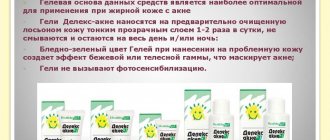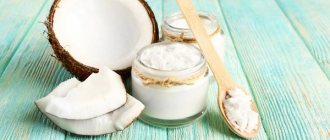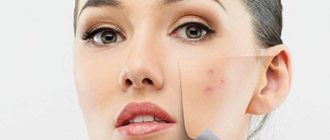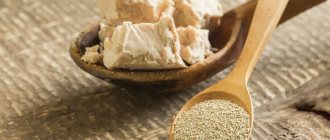Acne is the most common skin disease among teenagers, affecting up to 80-90% of young people. Although acne is not a life-threatening disease, localization of the process on visible areas of the skin can significantly affect the social and psychological adaptation of the individual. Moreover, 74.8% of patients with acneiform skin lesions belong to the age group over 18 years [1]. Recently, some researchers have noted a trend toward “maturing” acne. In 12% of women and 3% of men, the disease lasts an average of 44 years [2, 3].
Despite numerous studies of the pathogenesis of acne, there is still no complete clarity. According to modern concepts, the occurrence of acne is associated with a change in the physiological state of the sebaceous glands, and the process is considered as one of the constituent parts of the seborrheic process, which is complex in etiological and pathogenetic terms. The main pathophysiological mechanisms that lead to the development of acne include the following.
1. Disorders of hormonal regulation, accompanied by an increase in the level of androgens and an increase in their effect on the sebaceous gland. As a result, hyperproliferation of the basal layer of the sebaceous glands occurs, their hyperplasia occurs and the secretion of sebum sharply increases. A direct relationship has been proven between the amount of sebum secretion and the severity of skin lesions in acne.
2. Changes in the chemical composition of sebum, in which there is a significant decrease in triglycerides, which leads, in particular, to an increase in its density and a decrease in bactericidal properties.
3. Disturbances in keratinization processes, especially at the mouths of hair follicles. As a result of follicular hyperkeratosis and due to increased sebum density, the sebaceous duct is “blocked.” In the sebaceous gland, the number of sebocytes increases, as a result of which the synthesis increases and accumulation of fatty substances occurs, and in the future the development of purulent-necrotic processes is possible due to trophic disorders in the cells, since a significant part of the sebocytes is isolated from the source of nutrition - the basal layer.
4. According to most authors, an important secondary role in the pathogenesis of acne is assigned to the bacterial microflora of the hair follicles and sebaceous glands. In patients with acne vulgaris, Staphylococcus aureus, Propionibacterium
acne
and
Pityrosporum ovale
. Corynebacterium acne and Staphylococcus aureus secrete the enzyme lipase, which decomposes sebum triglycerides into free fatty acids. The latter, having an irritating effect on the skin, contribute to periglandular and perifollicular inflammation. However, it is known that the formation of comedones and the development of inflammation can also occur under sterile conditions [4]. The appearance of macrophages in the lesion increases the blockage of the gland [5, 6].
There are more than 25 methods (indices) for assessing the severity of acne. For practical use, the most convenient classification, modified by domestic dermatologists, is proposed by the American Academy of Dermatology:
— I degree is characterized by the presence of comedones (open and closed) and up to 10 papules;
— II degree — comedones, papules, up to 5 pustules;
— III degree — comedones, papulopustular rash, up to 5 nodes;
— IV degree is characterized by a pronounced inflammatory reaction in the deep layers of the dermis with the formation of multiple painful nodes and cysts [7].
When choosing treatment tactics, the severity of the disease is taken into account. In severe and moderate forms of the disease, systemic therapy is indicated. For mild and moderate forms of acne, treatment is aimed at reducing follicular hyperkeratosis, stopping the inflammatory reaction and normalizing the functioning of the pilosebaceous follicle. External treatment is used for any severity of acne and should include drugs with antimicrobial action, retinoids, and azelaic acid. In severe forms, the combination of external and systemic therapy (isotretinoin, antibiotics) is optimal [8, 9].
Topical retinoids are considered a new direction in the treatment of mild to moderate acne. Among the local retinoids today, the most famous is adapalene, produced in the form of a 0.1% gel.
Adapalene is a retinoid metabolite that has anti-inflammatory and pronounced comedolytic (affects open and closed comedones) effects, normalizes the processes of keratinization and epidermal differentiation. Reduces the binding of follicular epithelial cells at the mouth of the pilosebaceous follicle, involved in the formation of microcomedones. It is not recommended to use the drug during pregnancy and lactation. If the drug accidentally gets on the mucous membranes of the eyes, mouth or nose, rinse them thoroughly with warm water.
Retinoids increase skin sensitivity to ultraviolet radiation and when prescribing them, you should use sunscreen (for example, moisturizers with SPF), avoid visiting solariums and avoid sunbathing [10]. Adapalene applied to the skin in the evening can be combined with acne medications used in the morning.
Azelaic acid is included in both Russian and foreign standards for the treatment of acne. Azelaic acid has a moderate anti-inflammatory effect, reduces the metabolism of neutrophils and reduces their production of free radical forms of oxygen, suppresses the release of inflammatory cytokines, eliminates hyperkeratosis at the mouth of the sebaceous gland follicle, which, with long-term use, ensures the normalization of the differentiation process of epidermal cells [11-13].
Azelaic acid is a saturated dicarboxylic acid of natural origin (found in cereals, meat, and can be synthesized in small quantities by normal skin during lipid metabolism). After application to the skin, azelaic acid easily penetrates the epidermis and dermis. Up to 4% of the total dose enters the systemic circulation. Due to the presence of two carboxylic groups, azelaic acid is able to form complexes with divalent calcium and magnesium cations, cofactors of enzymatic reactions, and also bind free radicals [14].
In addition, azelaic acid suppresses melanin synthesis through inhibition of the enzyme tyrosinase [15], which can attenuate skin pigmentation and be used to treat post-inflammatory hyperpigmentation [8, 11, 12].
Azelaic acid also has an antiandrogenic effect, inhibiting the synthesis of type I 5α-reductase, which leads to a decrease in the content of dehydrotestosterone in sebocytes, thereby normalizing the processes of keratinization and sebum secretion [16].
There is data on bactericidal action against gram-positive and gram-negative microorganisms, including P.
acnes
and
Staphylococcus epidermidis
, including antibiotic-resistant strains [17]. Azelaic acid is effective with long-term use; the formation of microbial resistance to this drug has not been observed [11, 12].
In the literature of recent years [18], there is information on the antifungal effect of azelaic acid. in vitro experiments
It has been shown that 1% azelaic acid has an effect on fungi of the genus
Pityrosporum ovale, Candida albicans
, which are resistant to antibiotics.
Due to the fact that this acid is skin-friendly, non-toxic, and does not have mutagenic properties, pregnancy and lactation are not contraindications for its external use [19]. Within the framework of the import substitution program, the most interesting drug is a Russian-made product - 15% azelaic acid gel Azelik
.
which is part of the Azelik
, restores the barrier properties of the skin and improves the tolerability of the drug. Being an emollient, squalane does not have comedogenic properties. Microdrops of squalane fill the spaces between the scales of the stratum corneum of the epidermis, eliminate the feeling of tightness, soften and deeply moisturize the skin [20, 21].
Gel Azelik
Apply a thin layer to previously thoroughly washed (with water or cleansed with a mild cleanser) and dried facial skin, 2 times a day and rub in lightly. Approximately 2.5 cm of gel is enough for the entire face. The drug should be used regularly throughout the course of treatment [22].
Due to increasing antibiotic resistance to other antibacterial drugs, clindamycin has recently been preferred among topical antibiotics [8]. Clindamycin phosphate, after application to the skin, is quickly hydrolyzed by phosphatases in the ducts of the sebaceous glands and comedones to form clindamycin, which has antibacterial activity against strains of P. acnes
[23].
A domestically produced drug is 1% clindamycin gel Klindovit
.
The insufficient effectiveness of antibiotic therapy for acne may be due to the following factors: the prescription of inadequate doses of an antibacterial drug, a short course of therapy; high, more than 2.5 mg/cm2 per minute, rate of sebum excretion, making it difficult to create the required concentration of the antibiotic in the pilosebaceous follicle; the presence of gram-negative folliculitis that developed while taking an antibiotic, resistance to P. acnes
to the antibacterial agent used. To reduce the development of resistant strains and increase the effectiveness of therapy, there is a need to develop new combination regimens for complex therapy in the treatment of acne [2, 24].
Despite significant advances in acne therapy, the problem of improving treatment remains relevant. In case of pronounced social maladjustment, even in mild forms of the disease, already at the beginning of treatment it is necessary to give preference to complex and the most effective combined methods [8, 25]. Complex therapy for patients is aimed at the main links in the pathogenesis of acne and helps to normalize the secretion of androgens and reduce the activity of 5α-reductase, reduce the sensitivity of androgen receptors to testosterone and its active metabolites, normalize sebum secretion, reduce follicular hyperkeratosis and stop the inflammatory reaction [25]. A combination of drugs that affect at least two stages of pathogenesis, as a rule, significantly increases the effectiveness of therapy [26]. Therefore, we conducted a study that compared several acne treatment regimens:
a) in patients with papulopustular acne with a predominance of papules, the effectiveness of monotherapy (0.1% adapalene gel) and a combination regimen (0.1% adapalene gel in combination with 15% azelaic acid gel Azelik)
).
Retinoids (0.1% adapalene gel) achieve three of the four goals of therapy (normalization of sebum production, keratolytic activity and partial anti-inflammatory effect). Azelik
to the regimen , an effect on the fourth link of pathogenesis is achieved, the effects described above are enhanced, and a bacteriostatic effect is added (it is important that resistance is not developed), post-inflammatory hyperpigmentation is eliminated at the very beginning of its occurrence;
b) in patients with papulopustular acne with a predominance of pustules, the effectiveness of monotherapy (1% clindamycin gel Klindovit)
) and a combined regimen (1% clindamycin gel
Klindovit
in combination with 15% azelaic acid gel
Azelik
).
Clindovit
affects only two parts of the pathogenesis of acne (bacterial and inflammatory).
Advantages of the combined scheme:
1) impact on all four links of acne pathogenesis;
2) azelaic acid ( Azelik
) has a keratolytic effect - improves the penetration of the antibiotic into the site of inflammation;
3) Azelik
eliminates post-inflammatory pigmentation;
4) Azelik
normalizes sebum production;
5) Azelik
adds a bacteriostatic effect (without the development of microflora resistance), reduces the microbial load on the antibiotic (1% clindamycin gel
Klindovit
), which leads to a decrease in the development of antibiotic resistance.
The purpose of the study is to compare the effectiveness and safety of the use of Azelik
(15% azelaic acid gel),
Clindovit
(1% clindamycin gel),
Klenzit
(0.1% adapalene gel) in the complex therapy of patients with mild to moderate acne.
Composition and release form
Delex-Acne acne gel
| Gel for external use | 1 tube |
| deionized water | |
| purified sulfur | |
| plant extracts | |
| menthol | |
| carbopol | |
| sodium hydroxide | |
| polyols | |
| preservative | |
| flavoring |
in tubes of 30 ml; 1 tube in a cardboard box.
Delex-Acne cleansing lotion
| Facial lotion | 1 fl. |
| deionized water | |
| lemon acid | |
| menthol | |
| plant extracts | |
| glycerol | |
| Cato | |
| aromatic solution | |
| food colorings | |
| cethiol |
in bottles of 100 ml; 1 bottle in a cardboard box.
pharmachologic effect
Pharmacological action: local anti-inflammatory.
The effectiveness of acne treatment largely depends on correctly selected external agents, which implies the use of keratolytic, sebostatic and anti-inflammatory drugs. In addition, modern external agents should have not only antibacterial properties against Propionibacterium acne, but also an antimycotic effect. Sulfur has always been a classic effective remedy against demodex.
The gel has anti-inflammatory, sebostatic (drying), antibacterial and absorbable effects. In addition, a gel containing sulfur is active against acne, often complicated by demodex - a small parasite that lives on the skin of every second of us and is activated in the affected sebaceous follicle in the presence of acne and seborrhea.
The lotion has a cleansing effect.
Results and discussion
The study included 146 (37.8%) men and 240 (62.2%) women aged 13–44 years. Participants aged 15-25 years accounted for 68%, and 139 (36%) people were over 25 years of age. The average age of the group was 23.97 years (Table 1).
Table 1. Characteristics of groups
The diagnosis of L70 was made in 336 (87%) patients, L70.8 - in 15 (4%) patients, and L70.9 - in 35 (9%) patients, who were prescribed additional examination and subsequently underwent treatment adjustment.
At the time of treatment, the majority of patients (64%) had suffered from acne for 1 to 3 years. 14.5% of participants suffered for more than 8 years. All patients were repeatedly treated independently on the recommendation of relatives and friends, and the media. A common mistake, in our opinion, was incomplete courses of therapy and non-compliance with personal hygiene rules (Fig. 1).
Rice. 1. Duration of the patient’s illness.
Rice. 2. Dynamics of clinical changes in patients with acne during a course of treatment with Clindovit in combination with Azelik for 2 months, then monotherapy with Azelik for up to 6 months (best result).
During the initial examination, comedones were determined mainly from 10 to 30 pieces in the lesions (from 75 to 84%) in all groups. More than 40 comedones were rare (1-6%).
There were mainly 20 to 30 papules and pustules in the lesions (78-91%) (Table 2).
Table 2. Clinical manifestations on the skin at the first dose, abs. (%)
There were single nodes in the lesions, less than 5 (16-34%). More than 5 nodes were observed in 1-10% of cases. Dyschromia was much more common and was considered as a variant of post-acne. 29% of patients had single scars in the lesions.
As a result of the therapy, all patients in all groups showed positive dynamics of the skin process by the end of the 6th week (Table 3).
Table 3. Results of therapy by group Note. I - after 1 week of therapy; II - after 2 weeks of therapy; III - after 6 weeks of therapy.
After 1 week of treatment, subgroup Ia showed a slight improvement. Some patients noted a deterioration in their condition in the form of dryness and flaking of the skin, mild erythema and mild itching in the lesion. After 2 weeks, more than half of the patients noted an improvement in the skin process. By the end of the study, 77% of patients showed clinical recovery or significant improvement.
In subgroup IIa, by the end of the 1st week, more patients noted a lack of effect from treatment and increased dry skin. After 2 weeks, compared with group Ia, fewer people noted an improvement in the process and a larger number reported no effect from treatment. At week 6, clinical recovery was noted in a small proportion of patients (33%), and a significant improvement in the process was observed in half of the patients.
In subgroup Ib, by the end of the 1st week of treatment, no improvement or worsening of the process was observed in a larger number of patients. There were complaints of skin irritation, erythema, burning sensation, itching, and peeling. At the second examination after 2 weeks, process improvement and significant improvement were observed in a large proportion of patients (87%). The best result was noticed after 2 months of treatment: clinical recovery or significant improvement in the skin process was noted in 86% of patients.
In subgroup IIb, by the end of the 1st week, more than half of the patients noted worsening of the process and no improvement. At the second visit, clinical improvement was significant, but after 1.5 months the number of patients with clinical recovery and with significant improvement was small (14 and 47%, respectively).
No adverse reactions requiring discontinuation of the drug were identified during 6 weeks of observation. During treatment, many patients noted the appearance of burning, itching, redness and a feeling of dry skin after applying the drug. Analysis of paraclinical results during therapy in both groups did not reveal deviations from normal values (Tables 4, 5).
Table 4. Interpretation of the values of the DIQI index
Table 5. Data on the results of DIQ in patients with acne in groups
In subgroup Ia, the disease had a very strong (74%) and extreme impact on patients before treatment. After treatment, the skin disease had little or no effect on the majority of patients (84%).
In subgroup IIa, the survey results were different. At the start of treatment, patients were affected excessively to severely by the disease (56%). At the end of treatment, the disease practically did not change the patient’s life in only 61%.
In subgroup Ib, before treatment, the disease also had a very strong impact on patients. More than in other groups, patients noted an extremely strong (17%) impact on life. For 49%, the skin condition had a very strong impact. After treatment, the skin disease had little or no effect on the majority of patients (75%).
In subgroup IIb, at the beginning of treatment, the disease affected patients moderately to severely in 54% of cases. At the end of treatment, the disease practically did not change life in 64% of patients.
Component Properties
Gel. Biological components of the gel, incl. and activated sulfur, penetrate the sebaceous follicles, prevent the increase in sebaceousness and reduce inflammation, helping to eliminate acne and pimples. In this case, the inflammatory nodules on the skin turn pale, decrease in size and resolve faster. Gives the skin a matte and velvety feel. The gel form of the drug is the most optimal basis for use in oily seborrheic skin, in contrast to creams and ointments, which themselves can provoke the proliferation of harmful bacteria.
Lotion. Thanks to active ingredients, a balanced pH value, and a small amount of alcohol-containing substances, it gently cleanses the skin, removing excess lipids and acne bacteria from the surface of the skin. Creates optimal skin pH, reduces excess shine and makes skin clean and fresh.
What is cosmeceuticals?
Cosmeceuticals are “medicinal” cosmetics, which are at the intersection of cosmetology and pharmaceuticals. It is supposed to not only help care for the skin, but also have a therapeutic effect, helping to cope with problems such as acne, hyperpigmentation, scars, etc. But in reality, cosmetics cannot heal, they simply do not have such a right. The production of medicines and cosmetics is subject to different types of control, and methods of testing finished products differ.29
The prefixes “pharmacy” or “medicinal” next to the word “cosmetics” do not turn it into a medicine. Do not confuse oily skin (which produces a large amount of sebum) with problematic skin (essentially diseased, prone to acne and other dermatoses). But correctly selected products in accordance with the climate, season, existing problems, and skin needs can really improve its appearance and help prolong the remission of certain diseases.29
Let's give an example: if the owner of oily skin has acne, he needs both a drug that will affect the pathogenesis, including hyperproduction of sebum, and “medicinal” cosmetics that will mattify, absorb sebum, and cleanse the face. That is, you should not give up medications in favor of cosmetics and vice versa, they must be used in combination.
For the treatment of mild to moderate acne (including in the presence of papulopustular elements), Azelik® gel can be used. It contains azelaic acid, which can affect a large number of links in the pathogenesis of acne.5
Please note that cosmetics manufacturers can indicate anything on their products, for example, rejuvenates, eliminates acne, fights pigmentation. But pharmaceutical companies cannot afford this, since every effect of a drug must be confirmed by test reports. Therefore, you should not expect much from cosmetics.
Directions for use and doses
Externally.
Delex-Acne cleansing lotion
Use a cotton swab moistened with lotion to gently clean the inflamed areas of the skin. Can be used twice a day, morning and evening, and also before applying acne gel.
Delex-Acne acne gel
Apply a thin layer of gel to previously cleansed skin of the face or body 1-2 times a day in the morning and/or evening (for very oily skin - on the entire face; for combination skin - only on areas where acne and pimples accumulate) and leave for the whole day or for night. The gel is not visible on the skin, so it is very convenient to use. Duration of use is from 1–2 weeks until signs of inflammation completely disappear. For severe acne - in combination with other medications recommended by your doctor.
Which anti-acne* cream is better: one bought at a pharmacy or in a store?
Mass-market cosmetics are products for the care, including problem skin, that are available to most consumers. They are sold in pharmacies, specialty stores, and regular supermarkets. The problem is that some consumers perceive anti-skin products purchased at the pharmacy as drugs with a therapeutic effect, but this is not always the case.
Although cosmeceuticals cannot be considered a complete remedy for acne* on the face and body, they should not be considered useless. If we are talking about professional lines, it has a balanced composition, in which each component complements the action of the others. Cosmeceuticals undergo clinical testing (albeit not with such strict control as drugs), and their formulas are scientifically proven.
Cosmetic creams that help protect the skin from acne* and comedones (through moisturizing, nutrition, antioxidant action, etc.) contain mainly components of natural origin. Their action is aimed at improving regeneration and metabolic processes, reducing the formation of free radicals, protection from UV, etc.234
The following components can be found in cosmeceuticals234:
- squalene, which binds water, promotes the healing of microcracks;
- Fatty acids of plant origin help restore the hydrolipid mantle and hinder the penetration of pathogenic microflora into skin cells;
- amino acids that help accelerate metabolic and regeneration processes;
- natural polysaccharides that increase cell regeneration, inhibit inflammation, and have antioxidant properties;
- vitamins and microelements;
- SPF filters.
At the same time, cosmetic face creams cannot fight acne. If the manufacturer claims that his product changes the structure of the skin at the cellular level, affects the processes occurring in it, and penetrates into its deep layers, then we are talking about a therapeutic effect, which must be confirmed by appropriate research.29
special instructions
Lotion and gel "Delex-acne" combine well and complement each other; The skin is treated with lotion before applying the gel, which enhances the anti-acne effect of the gel and makes it faster and more durable.
If, after prolonged use, the oiliness of the skin has significantly decreased or even dryness has appeared, the gel should be applied pointwise, only to the inflamed elements. In addition, it is recommended to apply the gel to red spots remaining after acne, because... the drug promotes their resorption.
The pale green color of the gel, when applied to acne with a red-bluish tint, creates the effect of a beige flesh tone, which slightly masks inflamed areas of the skin.









